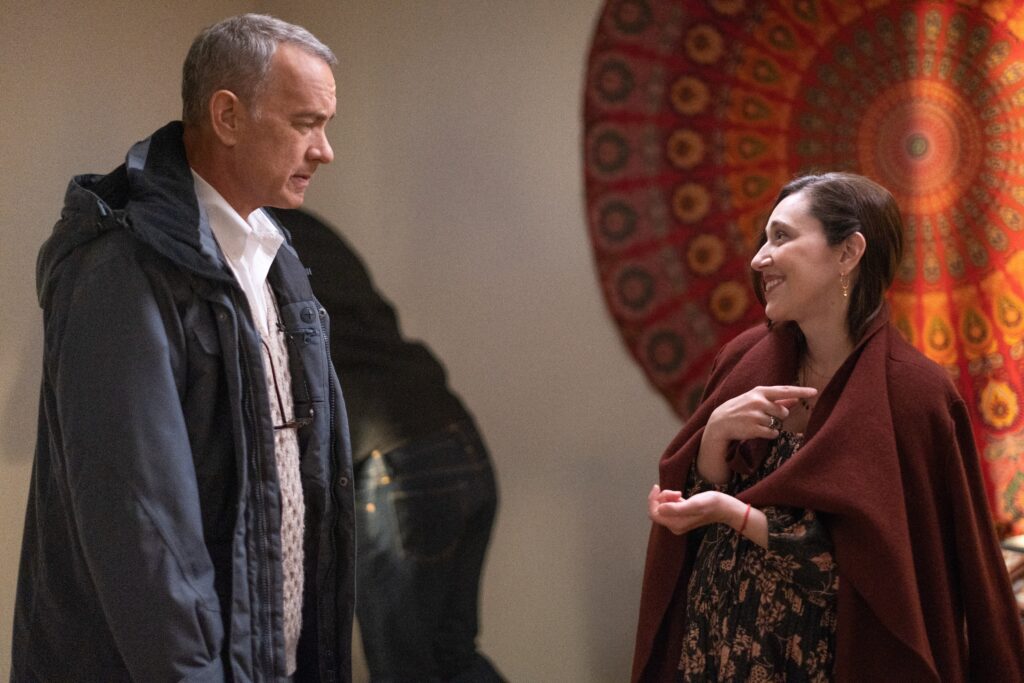In the shadow of the historical Carrie Furnace complex, film studios are on the rise.

Start with a sea of mud near the bank of a river. It’s hardly inspiring — not yet. But add some tax-credit magic and a dash of pixie dust. Voila: Pittsburgh really will be Hollywood on the Mon by 2024.
Ground was broken late last year on the construction of film studios at RIDC Carrie Furnace along the Monongahela River in Rankin, right next to the historical blast furnaces.
It will begin with a 52,000-square-foot structure to house at least two sound stages at a cost of $20 million, the vision of the Pittsburgh Film Office.
Next to this will be a 60,000-square-foot “tech flex” multipurpose building (a $15 million project). Once the latter is leased, a second, similar tech flex building will follow.
And all involved say there is room to grow.
This venture between the Regional Industrial Development Corporation and Allegheny County is “sort of the missing piece in our Mon Valley charm bracelet,” says Timothy White, RIDC’s senior vice president, business and development strategy.
The film office has assisted in more than 200 films and TV productions in southwestern Pennsylvania since it was established in 1990. And although the region has been home to major productions — ranging from “The Dark Knight Rises” to two projects about Fred Rogers — film crews on those projects have had to use retrofitted studios that began life as vastly different structures.
“We’ve made do with repurposed warehouses,” says Dawn Keezer, the director of the film office for 28 years. “We’re fortunate to have 31st Street Studios, fortunate we have the [former] American Eagle distribution clothing place out in Warrendale.”
Other local facilities have been used as sound stages, including spaces in Carnegie, Churchill, an airport hangar and the WQED studios in Oakland.
“But the industry has changed, the need has changed,” Keezer says. “The amount of technology that’s needed for these facilities to operate effectively and efficiently? People have different requests now.”

Silver Screen Gold Rush
MovieMaker magazine recently bumped Pittsburgh into the big leagues, naming it one of the top 10 big cities for filmmaking with its 2023 “Best Places to Live and Work.” (Atlanta was No. 1.) The magazine had previously ranked Pittsburgh a “small town,” based on its population.
But now “it can hold its own against much bigger cities,” MovieMaker editor Tim Molloy wrote about Pittsburgh. “Shockingly affordable, especially given its beautiful housing stock, it boasts architecture that begs to be filmed, rolling hills, countless bridges crossing its three rivers, and world-class museums, music and food.
“People who visit from elsewhere often wonder why no one’s ever told them how cool Pittsburgh is, so folks: We’re telling you now.”
Attracting film and TV projects is more competitive than ever. No one can compete with the likes of Los Angeles and New York City — and much more recently the state of Georgia, which has unlimited film tax credits to offset production costs. Then there’s the Great White North powerhouses of Toronto and Vancouver.
Yet other cities have jumped in. Louisville, Kentucky, for example, recently announced its intent to construct a $65 million studio. According to the proposal, the historic Louisville Gardens will be renovated to include 40,000 square feet of studio space in addition to retail, office and museum space. Groundbreaking is expected later this year with completion expected in 2025.
Kentucky has reinstated its film tax credit program, with 30%-35% of what is spent returned to the visiting projects. It’s capped at $75 million per year.
The greater Pittsburgh region, with a rich history bolstered by the story of George A. Romero and his “Night of the Living Dead” franchise, has done well for itself. It often stands in for other cities, such as New York — or Gotham — in “The Dark Knight Rises,” Washington, D.C., in some scenes of the series “Mindhunter,” Indianapolis in “The Fault in Our Stars” and, currently, Kingstown, Michigan, in the Paramount+ series “The Mayor of Kingstown.”
It’s even played itself on occasion — including in acclaimed films such as “A Beautiful Day in the Neighborhood” and “Fences.”
When the Cinemax series “Banshee” moved production for its final season — from North Carolina to Vandergrift — producers say they were thrilled to find locations that actually were fitting backgrounds for the story set in a small Western Pennsylvania town.

Meeting Demand
But locations and come-as-you-are converted soundstages are not actual studios, and the RIDC project aims to attract even more projects.
“In 2021, we had 11 [major] projects shoot in southwestern Pennsylvania, a record-breaking year. They spent $338 million while they were here,” Keezer says.
Admitting she sounds “like a broken record,” she adds that there could have been even more projects. “We are getting an additional $30 million this year,” she says, referring to the film tax credits — shared throughout the state — that state lawmakers raised from $70 million to $100 million.
“Which is great, but understand, we had $250 million worth of applications. The program is still woefully underfunded and oversubscribed.”
There is no blueprint for what makes a city or region a shoo-in for production. In Nevada, where a total of 415 projects were shot between June 2021 and June 2022, the tax credit cap is $10 million per fiscal year, with any unused rolled over.
But the Nevada Film Office is part of the state government, which leads to “synergies with other state agencies and municipalities — and our services are offered free of charge to our clients,” says Danette Tull, production and communications manager.
Obviously, the Strip in Las Vegas is a huge draw. But many other sites are popular locations, including the Mob Museum (also in Vegas), ghost towns, Virginia City and the Pioneer Saloon in Goodsprings, near the California border.
One of Pittsburgh’s most filmed backdrops is the Carrie Furnace itself, which has been used for numerous productions including the Christian Bale feature film “Out of the Furnace,” the series “One Dollar” and “Hemlock Grove” and even “Antiques Roadshow” and “American Ninja Warrior.” For the Showtime TV series “American Rust” — currently in production for its second season on Amazon Freevee — Carrie Furnace was the site of a key murder.

Building Stages and Partnerships
Recycling former brownfield sites such as Carrie Furnace — a remnant of the former U.S. Steel Homestead Works — has been aided by the commonwealth’s Act II of 1995, a law that “creates a realistic framework for setting cleanup standards, provides special incentives for developing abandoned sites, releases responsible parties from liability when cleanup standards are met, sets deadline for Department of Environmental Protection action and provides funding for environmental studies and cleanups,” according to the Department of Environmental Protection’s website.
For RIDC and the four municipalities (Rankin, Swissvale, the City of Pittsburgh and Braddock) involved, teaming up with the Pittsburgh Film Office was a logical next step.
“It really is a critical partnership to have that industry insight, combined with the real estate development knowledge that RIDC brings,” says Don Smith, RIDC president.
“We would be delighted to build out the whole site in the next year but the reality is, it’s an incremental process,” he says. “We will get the first set of soundstages up, the first tech flex building, and the market will respond to that.”
“We haven’t had neighbors for a long time but it is an opportunity to bring a lot of dollars into this region … [The Film Office has] proven time and again they can bring a lot of economic power and provide an awful lot of jobs,” said Ron Baraff, director of historic resources and facilities at Rivers of Steel. The nonprofit oversees the former furnace site, located in Swissvale.
To that end, the new facility will house a training center where some technical trades of filmmaking will be taught, such as electricians, hairstyle, grips and makeup.
This Pittsburgh Film Works program already has trained a group of grips and electricians, with hairstylists following last January. Funding for this comes from the film office, the state, Richard King Mellon Foundation and various economic development funds.
Unions such as IATSE 52, which represents motion picture studio mechanics and Local 489 (production technicians) and IATSE Local 798 (makeup and hair), help bolster the local workforce that will be needed for multiple productions.
“We want young people ready to go to work,” Keezer says, adding that the first classes have been inclusive of women and have BIPOC and LGBTQ+ representation.

Georgia on Their Minds
Keezer and an RIDC delegation traveled to Georgia in November to get an idea of what one member called “the Goldilocks tour” — the high-end facility, the low-end and the midstream.
“We drove more than 250 miles in less than 30 hours, and I never made it to Downtown [Atlanta],” Keezer says.
They toured EUE/Screen Gems, where the Netflix hit “Stranger Things” is shot. They went to the massive Trilith Studios just south of Atlanta, where Marvel Cinematic Universe films such as “Black Panther” and multiple “Avengers” installments were shot.
Trilith is one of the places in the country with what’s known as a “volume” soundstage. Imagine a capsule of screens (ceiling included) that can place the actors in otherworldly locations, such as those featured in Disney’s “The Mandalorian” or just down a country road. It represents something else that Keezer says Pittsburgh can aspire to, albeit on a physically smaller scale: working studios, facilities for scenery and costume fabrication and also a village complex including retail and housing.
For the Rankin project, the two new sound stages would be capable of being sectioned into smaller, multiple studios.
“It doesn’t have to be that big,” Keezer says, comparing RIDC Carrie Furnace’s potential to Trilith. “We have 54 acres down at Rankin, right? Six stages would be 300,000 square feet of stage space.
“This is a start. I don’t expect this to be the only soundstage facility in Western Pennsylvania, but I think what this does is, it gets us moving in the right direction to keep the work coming.”
Maria Sciullo is a Pittsburgh-based journalist whose coverage of arts and entertainment found her scrambling around the old Carrie Furnace site on numerous occasions. It remains an awe-inspiring location.
This article appears in the April 2023 issue of Pittsburgh Magazine.
















